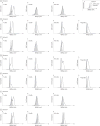Outcomes following gene therapy in patients with severe Wiskott-Aldrich syndrome
- PMID: 25898053
- PMCID: PMC4942841
- DOI: 10.1001/jama.2015.3253
Outcomes following gene therapy in patients with severe Wiskott-Aldrich syndrome
Abstract
Importance: Wiskott-Aldrich syndrome is a rare primary immunodeficiency associated with severe microthrombocytopenia. Partially HLA antigen-matched allogeneic hematopoietic stem cell (HSC) transplantation is often curative but is associated with significant comorbidity.
Objective: To assess the outcomes and safety of autologous HSC gene therapy in Wiskott-Aldrich syndrome.
Design, setting, and participants: Gene-corrected autologous HSCs were infused in 7 consecutive patients with severe Wiskott-Aldrich syndrome lacking HLA antigen-matched related or unrelated HSC donors (age range, 0.8-15.5 years; mean, 7 years) following myeloablative conditioning. Patients were enrolled in France and England and treated between December 2010 and January 2014. Follow-up of patients in this intermediate analysis ranged from 9 to 42 months.
Intervention: A single infusion of gene-modified CD34+ cells with an advanced lentiviral vector.
Main outcomes and measures: Primary outcomes were improvement at 24 months in eczema, frequency and severity of infections, bleeding tendency, and autoimmunity and reduction in disease-related days of hospitalization. Secondary outcomes were improvement in immunological and hematological characteristics and evidence of safety through vector integration analysis.
Results: Six of the 7 patients were alive at the time of last follow-up (mean and median follow-up, 28 months and 27 months, respectively) and showed sustained clinical benefit. One patient died 7 months after treatment of preexisting drug-resistant herpes virus infection. Eczema and susceptibility to infections resolved in all 6 patients. Autoimmunity improved in 5 of 5 patients. No severe bleeding episodes were recorded after treatment, and at last follow-up, all 6 surviving patients were free of blood product support and thrombopoietic agonists. Hospitalization days were reduced from a median of 25 days during the 2 years before treatment to a median of 0 days during the 2 years after treatment. All 6 surviving patients exhibited high-level, stable engraftment of functionally corrected lymphoid cells. The degree of myeloid cell engraftment and of platelet reconstitution correlated with the dose of gene-corrected cells administered. No evidence of vector-related toxicity was observed clinically or by molecular analysis.
Conclusions and relevance: This study demonstrated the feasibility of the use of gene therapy in patients with Wiskott-Aldrich syndrome. Controlled trials with larger numbers of patients are necessary to assess long-term outcomes and safety.
Figures



Comment in
-
An emerging era of clinical benefit from gene therapy.JAMA. 2015 Apr 21;313(15):1522-3. doi: 10.1001/jama.2015.2055. JAMA. 2015. PMID: 25898049 No abstract available.
References
-
- Albert MH, Notarangelo LD, Ochs HD. Clinical spectrum, pathophysiology and treatment of the Wiskott-Aldrich syndrome. Current opinion in hematology. 2011 Jan;18(1):42–48. - PubMed
-
- Thrasher AJ, Burns SO. WASP: a key immunological multitasker. Nat Rev Immunol. 2010 Mar;10(3):182–192. - PubMed
-
- Zhu Q, Zhang M, Blaese RM, et al. The Wiskott-Aldrich syndrome and X-linked congenital thrombocytopenia are caused by mutations of the same gene. Blood. 1995 Nov 15;86(10):3797–3804. - PubMed
-
- Imai K, Morio T, Zhu Y, et al. Clinical course of patients with WASP gene mutations. Blood. 2004 Jan 15;103(2):456–464. - PubMed
-
- Mahlaoui N, Pellier I, Mignot C, et al. Characteristics and outcome of early-onset, severe forms of Wiskott-Aldrich syndrome. Blood. 2013 Feb 28;121(9):1510–1516. - PubMed
Publication types
MeSH terms
Substances
Grants and funding
LinkOut - more resources
Full Text Sources
Other Literature Sources
Medical
Research Materials

